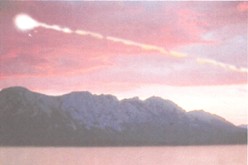 Petrography
Petrography
Chondrites
8 are undifferentiated meteorites characterised by chondrules, millimetre- sized spherical rocky beads. There are several schools of thought about their origin but the most likely origin is partial to complete melting of clumps of silicate mineral dust in the solar nebula. Chondrules are never found in terrestrial rocks, nor in the SNC achondrite meteorites attributed to a source on Mars; but very rare, round bodies in lunar surface breccias have been supposed to be chondrules. Many chondrites display secondary metamorphism, dry heating from the original partly glassy object (Type 3) and the progressive metamorphic stages are classified from Types 4-7, the chondrules being entirely lost by recrystallisation in the latter. In contrast some of the carbonaceous chondrites are of Type 3 or even higher, but the really primitive ones display increasing low temperature alteration in the presence of water, to form Ca-Mg-Fe carbonate minerals and sulphates such as epsomite, pseudomorphing the high temperature minerals olivine and pyroxenes. In the CM chondrites (named after Murchison fall, Australia) there are chondrules, but in the most primitive type of all, the CI chondrites (named after Ivuna fall, Tanzania, though the first and most famous is the Orgeueil meteorite fall, France7) there are no chondrules. Tagish Lake
3,4,5,12 has very few chondrules. It is matrix-dominated, this matrix being mainly of phyllosilicates, with also Fe-Ni sulphides and refractory Calcium-Aluminium Inclusions (CAIs). The olivine is highly magnesian (peak Fa1), as is the pyroxene (peak Fs2).
This meteorite is composed of two different rock types, one poor in carbonate minerals, the other rich in them12. Both are largely composed of low temperature minerals pseudomorphing original high temperature phases, though some of the latter are preserved residually. Though the presence of chondrules distinguishes this meteorite from the most primitive CI class such as Orgueil, the much fewer chondrules than Murchison (CM2) suggests that this meteorite is unique and should be allotted a new class CI2. Tagish Lake also has a lower density than any other chondrite meteorite known.
The chemical composition is also used to classify meteorites. On one parameter, the oxygen isotopic composition, Tagish Lake is very close to the most primitive CI1 chondrites, but different
4,9. The bulk composition reflects the degree of fractionation from the original solar nebula composition of the cloud of dust and gas at the start of the solar system10. The CI1 chondrites such as Orgueil are nearly unfractionated. Tagish Lake is closest to the CI1 and CM2 carbonaceous chondrites, and rather closer to the CM2 class.